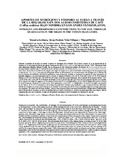| dc.rights.license | http://creativecommons.org/licenses/by-nc-sa/3.0/ve/ | |
| dc.contributor.author | Arellano G., Rosalva | |
| dc.contributor.author | Paolini, Jorge | |
| dc.contributor.author | Villegas, Elda | |
| dc.contributor.author | Robles, Miguel | |
| dc.date.accessioned | 2015-12-17T15:25:12Z | |
| dc.date.available | 2015-12-17T15:25:12Z | |
| dc.date.issued | 2015-07 | |
| dc.identifier.issn | 1690-3226 | |
| dc.identifier.uri | http://www.saber.ula.ve/handle/123456789/41388 | |
| dc.description.abstract | Durante el período de un año, se evaluó el aporte de nitrógeno (N) y fósforo (P) al suelo a través de la incorporación de la
hojarasca y su descomposición en dos agroecosistemas de café (Coffea arábica), ubicados en el Sector “Vitú”, Parroquia Santa
Ana, Municipio Pampán, Estado Trujillo. En el sistema A el café estaba bajo sombra de árboles de Ficus caruca e Inga spp,
principalmente, mientras que el sistema B era de café bajo sombra de árboles de Inga spp, Persea americana y Bixa Orellana,
entre otros. El estudio se realizó en tres etapas, una etapa de campo en la cual se determinó la descomposición de hojarasca por
el método de “litter bags”, una etapa de laboratorio donde se determinarón las concentraciones de nitrógeno (N) y fósforo (P)
por los métodos de kjeldahl y del azul de molibdeno, respectivamente, también se evaluaron los aportes de estos parámetros al
mantillo orgánico. Las concentraciones de N y P, para el sistema A fueron 2,10-3,00 % N de café; 1,30-2,07 % N de hojas de
árboles y 0,07-0,12 % P de café; 0,05-0,09 % P de hojas de árboles respectivamente. En el sistema B los aportes fueron: 2,03-
2,38 % N de café; 1,90-2,69 % N de hojas de árboles y 0,11-0,16 % P de café; 0,07-0,15 % P de hojas de árboles. Los aportes
de la hojarasca al mantillo orgánico en el sistema A fueron de N= 83,16 (kg/ha/año) y de N= 104,97 (kg/ha/año) para el sistema
B respectivamente. El aporte de P para A fue 3,61( kg/ha/año) y para B de 5,73 (kg/ha/año). Se observó un ligero incremento
de los valores de N y P en la hojarasca del sistema B, pudiendose atribuir estos resultados a que el sistema B posee diferentes
arboles de sombras con respecto al sistema A, no obstante la concentración de N y P en el mantillo orgánico en rasgos generales
son similares. El cultivo de café bajo sombra, proporciona un microclima adecuado de humedad y temperatura fundamentales
para el desarrollo de la planta, en áreas no óptimas para su cultivo, hecho que le confi ere una gran importancia ecológica. Para la
comparación entre los resultados se hizo uso del paquete estadístico SAS y el análisis de varianza de una vía. | es_VE |
| dc.language.iso | es | es_VE |
| dc.rights | info:eu-repo/semantics/openAccess | |
| dc.subject | Coffea arabica | es_VE |
| dc.subject | Nitrógeno | es_VE |
| dc.subject | Fósforo | es_VE |
| dc.subject | Producción y descomposición de Hojarasca | es_VE |
| dc.subject | Agroecosistemas | es_VE |
| dc.title | Aportes de nitrógeno y fósforo al suelo a través de la hojarasca en dos agroecosistemas de café (coffea arábica) bajo sombra en los andes venezolanos. | es_VE |
| dc.title.alternative | Nitrogen and phosphorus contributions to the soil through dead leaves in the shade in the venezuelan andes. | es_VE |
| dc.type | info:eu-repo/semantics/article | |
| dc.description.abstract1 | During one year period , the contribution of nitrogen (N) and phosphorous (P) to the soil through incorporating dead leaves
in decomposition in two coffee agroecosystems (coffee arabiga) located in the sector Vitú, Municipality of Pampán , Trujillo
State, was evaluated. In system A, coffee plants were mainly in the shade of trees like Ficus caruca and Inga spp, while system
B . consisted in coffee in the shade of trees like Inga spp., Persea Americana and Bixa orellana, among others. The research was
carried out in three stages ; a fi el stage in which decomposition of dead leaves was determined by means of the “litter bags”
method; and a laboratory stage where concentrations of nitrogen (N) and phosphorous (P) were determinated by means of the
Kjedahl and blue molybdenus methods, respectively, the controbutions of these parameters to the organic humus were evaluated
too. Concentrations of N and P in system A were 2,10 – 3,00 % of coffee, 1,30 – 2,07 % N of tree leaves and 0,07 – 0,12 % of
coffee, respectively. In system B, the contribution were: 2,03 – 2,38 % of coffee, 1,90 – 2,69 % N of tree leaves , and 0,11 – 0,16
% of coffee, 0,07 – 0,15 % of tree leaves. The contribution of tree leaves to the organic humus in system A were: N: 83,16 (Kg/
ha/year) and of N: 104,97 (Kg/ha/year) for system B, respectively. Constributions of P for system A was of 3,61 (Kg/ha/year)
and of 5,73 (Kg/ha/year) for system B. A light increase of values from N and P in dead leaves was also noticed. These results
can be attributed to the fact that system B has different shade trees with respect to system A; however, the concentration of N
and P in the organic humus are generally similar. Coffee farming in the shade provides an adequate microclime in humidity and
temperature, basic for the development of the plant in not best areas for that kind of farming; this fact confers it a great ecological
importance. For comparing these results the SAS statistical pack and the one-way variance analysis were used. | es_VE |
| dc.description.colacion | 21-30 | es_VE |
| dc.description.email | rosalva@ula.ve | es_VE |
| dc.description.email | miguelrobles2007@gmail.com | es_VE |
| dc.description.frecuencia | Trimestral | |
| dc.identifier.depositolegal | 200202TR1298 | |
| dc.publisher.pais | Venezuela | es_VE |
| dc.subject.facultad | Núcleo Rafael Rangel (NURR) | es_VE |
| dc.subject.institucion | Universidad de Los Andes (ULA) | es_VE |
| dc.subject.keywords | Coffee arabica | es_VE |
| dc.subject.keywords | Nitrogen | es_VE |
| dc.subject.keywords | Phosporous | es_VE |
| dc.subject.keywords | Dead leaves production and decomposition | es_VE |
| dc.subject.keywords | Agroecosystems | es_VE |
| dc.subject.publicacionelectronica | Academia | |
| dc.subject.seccion | Academia: Artículos de Investigación | es_VE |
| dc.subject.thematiccategory | Artes y Humanidades | es_VE |
| dc.subject.tipo | Revistas | es_VE |
| dc.type.media | Texto | es_VE |


